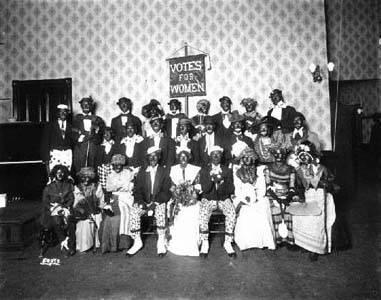Search | Image Archive | Reference | Communities | POV | Lesson Plans | Credits
 The suffrage movement first came to prominence in the 1880s and was led primarily by Icelandic women, who had enjoyed full property and voting rights in their native Iceland and asked for the same in their new country. They were joined by a variety of social reformers, mostly middle class, who saw the franchise either as a means of emancipation or as a means of maintaining their social position.
The suffrage movement first came to prominence in the 1880s and was led primarily by Icelandic women, who had enjoyed full property and voting rights in their native Iceland and asked for the same in their new country. They were joined by a variety of social reformers, mostly middle class, who saw the franchise either as a means of emancipation or as a means of maintaining their social position.
Many suffragists were also temperance crusaders who saw the vote as a means of ensuring that prohibition laws were passed. Temperance was by no means the only issue among suffragists. Their agenda included reform of property laws; equal guardianship of children; new divorce laws; and improved working conditions, better wages, and access to higher education for women.
Suffragists employed a variety of arguments to press their case. Some argued from the basis of natural law, arguing the equality of all. Some argued on the grounds that women were compelled to pay taxes on the property they owned, and therefore should not be subject to the injustice of taxation without representation.
Others saw suffrage as a means of addressing the common concerns of all women. Just as the rich and the regions were to be protected in the Senate, women demanded that their distinctive concerns needed to be acknowledged through direct representation in the legislative system. It was no longer sufficient, they argued, to have an indirect and subordinate relationship to the state as wives and daughters.
Some suffragists embraced arguments associated with the ideology that has come to be known as maternal feminism, arguing that as sisters and mothers, they were compelled to act in the public sphere to remedy the injustices and evils of modern society and use the gifts of their sex to purge politics of its distasteful and corrupt elements. They saw vigourous motherhood as a natural occupation that could act as a buttress against destabilising elements.
Still other employed nativist arguments, suggesting that British Canadian Women deserved the vote because the franchise had already been entrusted to naturalized immigrants from Central Europe, many of whom were supposedly far more vulnerable to corrupt electoral practises.
In 1912, a number of prominent middle class reformers in Winnipeg founded the Political Equality League. Under the charismatic leadership of Dr. Mary Crawford, Lillian Beynon Thomas and Nellie McClung, the League dispatched speakers across the province to spread the message of social reform through suffrage. In 1914, the League secured a promise from T. C. Norris' Liberals that if elected, his government would move immediately to grant the vote. By this time, suffrage had the support of not only the Political Equality League, but the Women's Christian Temperance Union, the Grain Growers Association and the Trades and Labour Council, to name but a few.
Norris was defeated in 1914 by the well-oiled "machine" of Sir Rodmond Roblin's Conservatives, and it was not until after the Roblin Government collapsed under the weight of its own corruption in 1915 that the vote was even considered.
Upon receiving petitions bearing over 40 000 names in December of 1915, Norris introduced suffrage legislation, which was passed in January of 1916. Manitoba became the first province in the Dominion to grant full voting privileges to women, and in the next decade, most of the provinces and the Dominion Government followed.
Page revised: 23 August 2009